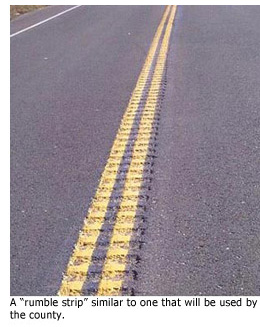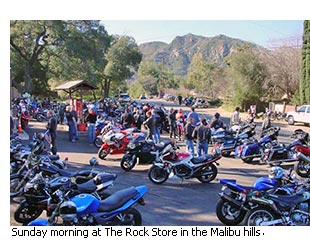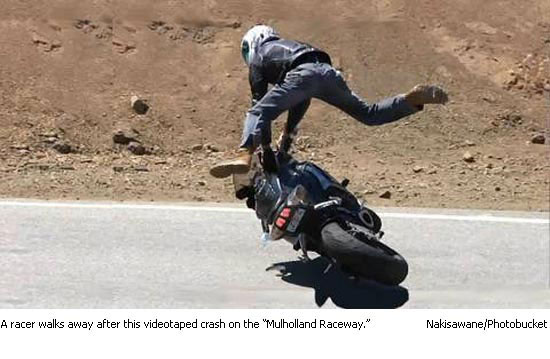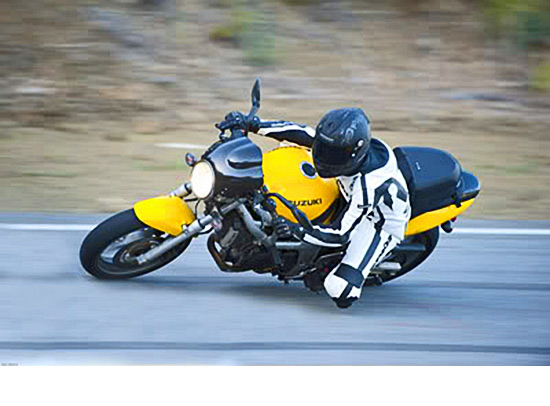Road warriors get ready to rumble
February 1, 2011
The switchbacks and hairpins of the Santa Monica Mountains have lured thrill seekers for generations. But starting this spring, Los Angeles County will be throwing speed demons a new kind of curve.
After years of study and preparation, the Department of Public Works will soon be installing speed-deterring “rumble strips” down the center lines of one of the most popular and storied amateur racing loops in Southern California: the section of the so-called “Mulholland Raceway” that starts and ends at Mulholland Highway and traverses Stunt, Schueren, Piuma and Cold Canyon roads.
The move comes at the behest of local homeowners, who for years have sought relief from the rip and roar of the high-performance sports cars and motorcycles that race through the canyons day and night. Over the years, authorities have tried various solutions, from increased traffic patrols to seizing the vehicles of illegal street racers, but the practice has persisted.
California Highway Patrol Officer Leland Tang says the patrol area around the Stunt-Piuma loop has averaged nearly 40 traffic collisions a year for the last several years. The collision average has been about 50% higher on the west side of Las Virgenes, Tang says, but the outcry on the east side has been more concentrated because that area is more densely populated. (Click here for a map of the loop.)
“It’s scary just to go to your mailbox,” says Mary Ellen Strote, who has lived near the top of Stunt Road since 1981.
Some are just Sunday drivers and law-abiding enthusiasts, she and other homeowners say, but too many others are revved-up young men testing their machines and their mettle.
“The tailgating, the passing on blind curves, the aggression,” Strote says. “You’ll be driving along, and there’ll be a bicyclist on one side and a motorcyclist in the other lane and then here will come some insane person, passing on a blind curve.”
Those curves—blind and otherwise—are the targets of the rumble strip project, says Todd Liming, senior civil engineering assistant at the county Department of Public Works.
During the past decade, residents have complained that street racing in the area has become an increasing danger, as drivers and motorcyclists—especially the inexperienced ones—have sought to shave seconds by cutting corners and darting across the center line in and out of oncoming traffic. Some race in packs, warning each other of law enforcement via text message and cell phone. Some yearn to emulate professional test drivers.
Strote and others say Stunt Road has become particularly popular because outsiders think—incorrectly—that it was named for Hollywood stunt drivers. (In fact, the road was named for the Stunt family, homesteading fruit-growers whose nearby ranch is now part of the University of California Natural Reserve System.) Over time, pressure has grown to find fresh solutions to the ongoing concern.
Initially, Liming said, area residents urged speed humps as a way to discourage racing, but humps posed too big a safety risk on the hilly and winding roadways. Improved signage helped, as did stricter enforcement, which was ramped up over the years as part of Operation Safe Canyons, a state and local task force led by Supervisor Zev Yaroslavsky’s office.
But traffic mitigation is particularly difficult in mountain areas, says Liming. And patrols can only do so much in an area as vast as the Santa Monica Mountains, Tang adds. Finally, after several years of study, county engineers came up with centerline rumble strips – sections of small grooves cut directly into the asphalt – as a possible way to deter corner-cutting, drifting and other dangerous aspects of what amateur racers call “canyon carving.”
The indentations, which are 5 inches wide and a little less than a half-inch deep, literally and figuratively underscore the double yellow line that separates lanes of opposing traffic.
Used for years along the sides of highways elsewhere to warn drowsy motorists that their cars might be straying onto the shoulder, rumble strips along the center line offer a similar warning to cars and especially motorcyclists who stray toward the middle of the road, rather than its edges, Liming says. The strips create an intense, unpleasant vibration when tires hit them and alter the road surface just enough to force cyclists to slow down in the event they decide to cross them—especially at high speeds and at an angle.
The solution is not without its own possible downsides. Although centerline rumble strips have been used successfully in other areas—the Pennsylvania Department of Transportation, for example, credited them last year with a 35%-50% reduction in crashes in areas on which they were installed—any change in the road surface can create hazards, especially for bicyclists and motorcyclists.
And homeowners may be trading one form of noise pollution for another: When tires hit the strips, however they’re positioned, it’s loud.
“This is a pilot project,” says Liming, who stresses that county engineers will be closely monitoring the effort. If the strips work, he says, they will eventually bisect the entirety of the 14.5-mile loop except for a short section on Mulholland Highway. This might lead to their use in other race-plagued roads in the area. The project is expected to cost $425,000 to $475,000, though federal grants are covering most of that price tag. The initial phase, put out to bid late last year, is expected to start in April.
The plan drew mixed reviews on a recent day at The Rock Store, the popular Mulholland Highway restaurant and biker hangout.
“What?! No way!” exclaimed veteran motorcyclist Scott Storey, a 53-year-old Canadian who says he’s been riding since the age of 15 and is still recovering from a fall on a blind curve that wrecked his Ducati in July. Storey expressed concern that rumble strips anywhere on the road might pose an accident risk to an inexperienced rider. He says that once a motorcycle loses traction, especially while leaning into a curve, only the most skilled can keep from crashing.
Pulling a camera from his pack, Storey shared some videos he’d just taken of rides along Stunt and Piuma, using a lens strapped to his chest. They provide a rider’s-eye view of the curving roadway and sheer cliffs along the loop, and illustrate the difficulty of negotiating these roads quickly.
“I figure if you can’t stay on your side of the road, you can’t drive very well,” says Storey. “I figure its best to live to ride another day. But some people, their idea is to get down the road as fast as possible to feel like a big man. And the fastest route is to ignore the double yellow lines.”
“It’s not gonna stop ‘em,” agreed Malibu photographer Paul Herold. “It’ll discourage the bikes, but the bikes aren’t crossing the double yellow anyway—anybody on two wheels up here will tell you that the first rule of canyon riding is to never cross the double yellow. The cars, though—the cars aren’t gonna slow down.”
Other enthusiasts, however, thought rumble strips might be worth trying.
“I used to live off Latigo Canyon in the 1970s, and there would be nobody when we’d ride, but it’s too congested now,” says Kaming Ko, a 56-year-old former motorcycle and auto racer who lives in Woodland Hills.
“You can’t change what people do, but you can discourage them from doing something stupid. They’re still going to go fast, but maybe this will help them maintain some integrity and get them to stay in their own lane.”
Posted 2/1/11














 405 bridge work causes a stink
405 bridge work causes a stink
